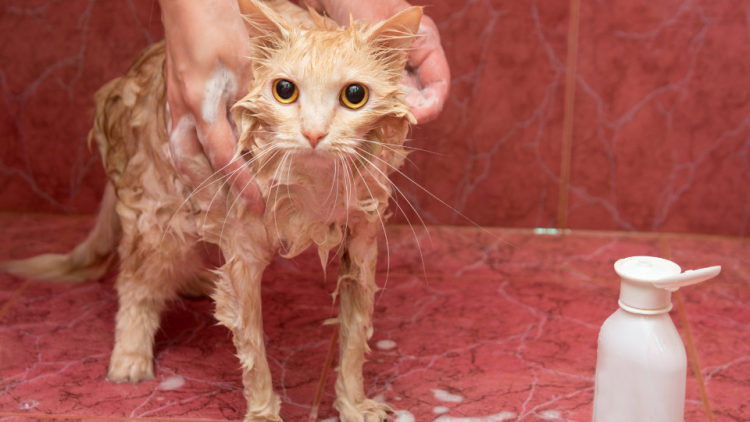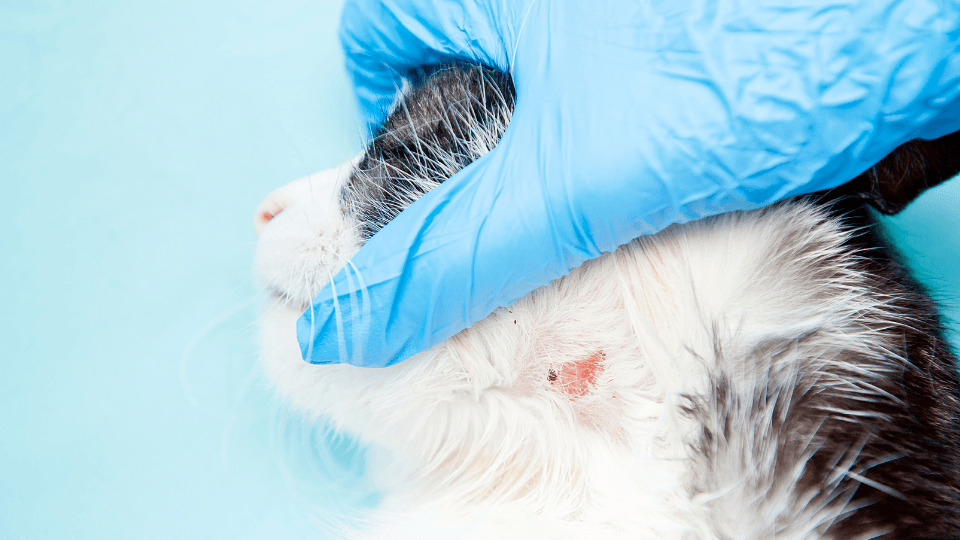Ringworm is a fungal skin infection often seen in felines, but despite the name, this disease actually has nothing to do with worms. If you suspect your cat has ringworm has this fungal condition, fast and thorough treatment is essential to prevent it from spreading to other pets and people in the home.
Thankfully, although it’s highly contagious, ringworm isn’t life-threatening and can be easily avoidable if you know what to do.
Table of Contents:
- What is ringworm in cats?
- How is ringworm spread to cats?
- Who is at risk of ringworm?
- What are the symptoms of ringworm in cats?
- Diagnosing ringworm in cats
- Treatment of ringworm in cats
- How long are cats with ringworm contagious?
- How to prevent ringworm in cats
- Key Takeaways
Pro Tip: If you have any concerns about your cat’s health, pet insurance can help ensure your companion gets the care they deserve at a price you can afford. Depending on the plan, you can receive reimbursement for the diagnosis and treatment of infectious skin diseases like ringworm.
What is ringworm in cats?
Ringworm, also known as dermatophytosis, is a fungal infection that affects cats, dogs, and other animal species including humans. Although the fungus is not a worm, the disease is called ‘ringworm’ because it often causes skin lesions that appear as circular patches of hair loss with crusting that resembles a worm.
There are more than forty different fungi, known as dermatophytes, that can cause dermatophytosis. Dermatophytes require keratin for growth and can result in a superficial infection of the skin, hair, and nails, which is where the keratin protein exists in both humans and animals. There are three species commonly responsible for ringworm in cats, but the majority of feline cases are caused by the fungal species Microsporum canis.
How is ringworm spread in cats?
Felines can carry the fungal spores without showing any clinical signs at all. These spores are easily spread through indirect and direct contact, so cats can get ringworm by touching infected animals as well as contaminated objects (such as food, toys, dishes, bedding, furniture, combs). Fungal spores in the environment can remain infectious for up to two years, especially in humid, moist areas, and they’re tough to kill.
The incubation period between exposure to ringworm fungus and the development of lesions is usually seven to 14 days, with some cases taking up to three weeks before the first signs of infection occur.
Who is at risk of ringworm?
Ringworm affects many animal species including cats, dogs, pigs, sheep, cattle, goats, rabbits, birds, and rodents.
Cats of any breed, sex, and age are susceptible to the infection. Healthy adult felines typically have some natural resistance to the disease, but cats under one year of age are more at risk because their immune systems aren’t fully developed. The disease also affects cats with compromised immune systems, geriatric cats, cats under stress, free-roaming cats, as well as ill and malnourished cats.
Genetic factors might also play a role, as Himalayan, Persian, and other longhaired cats seem to be more susceptible. Long-haired cats are believed to be more susceptible because the long hairs prevent the ringworm spores from being removed by grooming.
Although ringworm in animals is a self-limiting disease, meaning it cures itself over time, it’s highly contagious and easily transmissible, which is why most vets recommend treatment.
Ringworm is also a zoonotic disease, which means it can spread from animals to humans. Ringworm in people usually occurs after coming in contact with an infected or carrier animal, but it can also occur after handling objects that were used by the infected pet. Individuals with suppressed immune systems, such as children and the elderly, are more at risk of contracting ringworm.

Symptoms of ringworm in cats
Ringworm in cats often presents itself as round, reddish rings on skin. These patches of skin usually appear on the front legs, ears, or other parts of the head, but can pop up anywhere on the body, especially if the infection is severe.
Cats with ringworm might also develop a stubby, dull coat with patchy hair loss. Some felines might suffer from itchy or scaling skin and infected nails depending on severity. When ringworm occurs in the nails, it can cause them to grow malformed.
Diagnosing ringworm in cats
Felince ringworm lesions can look similar to other issues, such as feline acne or dermatitis caused by fleas, which is why it's often necessary for vets to run more than one test. When diagnosing a cat with ringworm, your vet may perform the following:
Wood's lamp. This test involves a special handheld lamp that uses a black light to illuminate areas of the skin, causing the fungus to fluoresce. The test is non-invasive and quite simple, but it is not always accurate. The light could also make other things fluoresce, such as topical ointments or dead skin cells.
Fungal culture. One of the most reliable ways to diagnose ringworm is to take samples of skin and fur from the lesions and place them on a special culture medium to see if the fungus will glow. The fungal culture test is very accurate but it can take up to three weeks to get the results.
Microsporum. This test involves picking up cells from the lesion using a piece of clear tape so that they can be stained. A purple stain is used to cause the fungal spores (called Microsporum) to be visible under microscopic examination, but the spores can still be difficult to spot.
Polymerase chain reaction (PCR). This is the newest method to detect ringworm. It is non-invasive and checks for fungal DNA in a hair or skin sample. The test must be conducted at a commercial vet lab and can provide results in five days.
Skin biopsy. This is the most invasive test used to confirm ringworm. It involves cutting out a piece of skin and analyzing it under a microscope. It usually takes a few days to provide results.
For more information about each of these tests, it’s best to speak to your vet.
Treatment of ringworm in cats
Oral medications. If your cat has been confirmed to have ringworm, your veterinarian will likely prescribe an antifungal medication. Itraconazole is the most commonly used drug but due to the size of the capsules, they have to be compounded into a liquid solution in order to be safely administered to cats. Oral medications are commonly prescribed for cats with severe generalized lesions, longhaired cats, as well as in cases where the nails are affected.
Be sure to consult your vet before giving your cat any oral medication as they can affect the liver. It is recommended to check liver enzymes before and during therapy.
Topical ointments. If your cat has small, sporadic lesions, the patches of skin will be likely treated with anti-fungal medications in the form of topical cream and medicated shampoo. In some cases, topical therapy is combined with oral medications to suppress the infection and kill the spores on the skin.
Depending on the severity of the case, oral treatments can be used in conjunction with medicated dips. Usually, a solution called lime sulfur is used, which is safe and effective at treating infected hairs, but has a bad odor and can temporarily turn your cat’s coat yellowish. If your cat is longhaired, the areas with lesions will be clipped in order for the dip to get in contact with the skin. In fact, some vets recommend cats with long fur to be shaved when they’re treated for ringworm.

Cost of ringworm treatment for cats
Fortunately, ringworm is not considered to be a particularly expensive infection. In fact, for animals with localized lesions in mild severity who respond well to topical treatment, the overall cost can come in under $100.
However, if the pet has multiple lesions and doesn’t respond to the drug medication or topical therapy, the cost can be significantly higher. Long-term treatment for ringworm can add up to $500 for some cases that are more difficult to treat.
Pro Tip: When you are looking for the best pet insurance value, it's important to find a plan that covers both exams and prescriptions. Accident and illness plans ensure coverage for diagnostic tests and medications, so owners can worry less about the cost of essential care.
How long are cats with ringworm contagious?
If aggressive treatment is used, infected cats remain contagious for about 21 days. If minimal measures are taken or if pet owners don’t strictly follow the vet-prescribed treatment, the infection will remain contagious for a longer period of time. Two consecutive negative cultures are necessary in order to confirm that your feline friend has been successfully treated.
When treated properly, the majority of cats will completely recover from a ringworm infection. Improvement in the appearance of the lesions should be evident within two to three weeks. If the treatment isn’t aggressive enough or is discontinued too early, or if the cat suffers from another medical condition that weakens its immune system, the symptoms might recur.
How to treat your home to kill ringworm
Ringworm can be easily transmitted to people, especially children, through environmental contamination, which is why it’s important to meticulously clean your home to kill any remaining fungal spores.
- Start by cleaning and disinfecting solid surfaces by using a diluted bleach solution. Keep the solution on the surface for 10 minutes to make sure the area is completely disinfected.
- Vacuum the carpets in order to remove all infected hairs and, if possible, steam clean them to eliminate the spores.
- Clean tile and hardwood floors with a damp, disposable cloth and avoid using brooms.
- Launder bedding, small area rugs, and soft items like toys. Vacuum drapes and upholstered furniture, and discard the vacuum cleaner bag. Use duct tape to remove any hair the vacuum missed from the furniture.
How to prevent ringworm in cats
Ringworm can be easily prevented if appropriate measures are taken.
The easiest way to minimize the likelihood of you and your pet getting infected with ringworm is to wash your hands before and after handling your cat. Also, don't allow your pet to play with animals that don't belong to your household, and be sure to maintain a clean and sanitary living environment.
If you're infected with ringworm, don’t touch your pet(s) until the doctor confirms you are infection-free.
Key Takeaways
- Ringworm is a fungal infection in cats that causes hair loss and red, circular skin lesions.
- The infection is highly contagious and can easily spread from cats to humans and other animals through direct contact and environmental contamination.
- Curing ringworm can take several weeks through oral medication and topical therapy, but treatment is effective in most cases.
- Be sure to get in touch with your veterinarian if you suspect your cat has ringworm.
